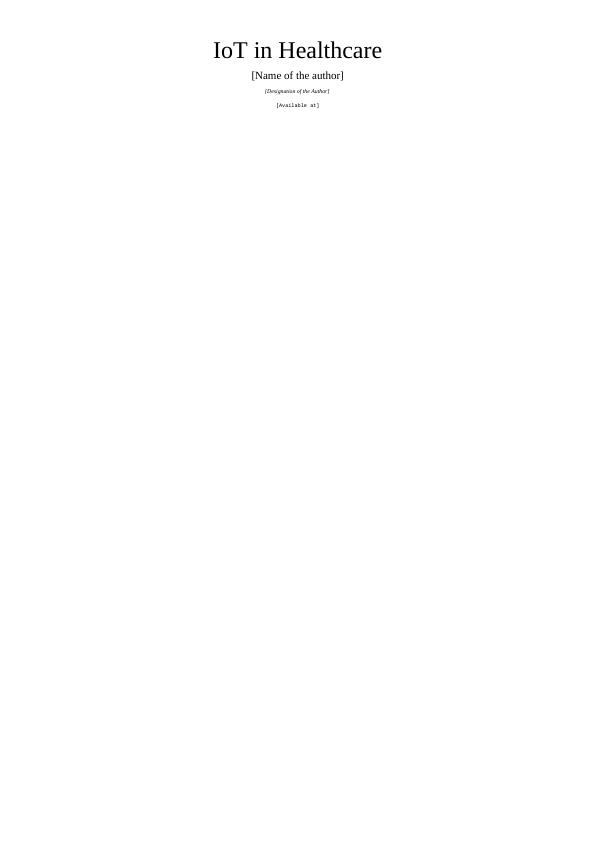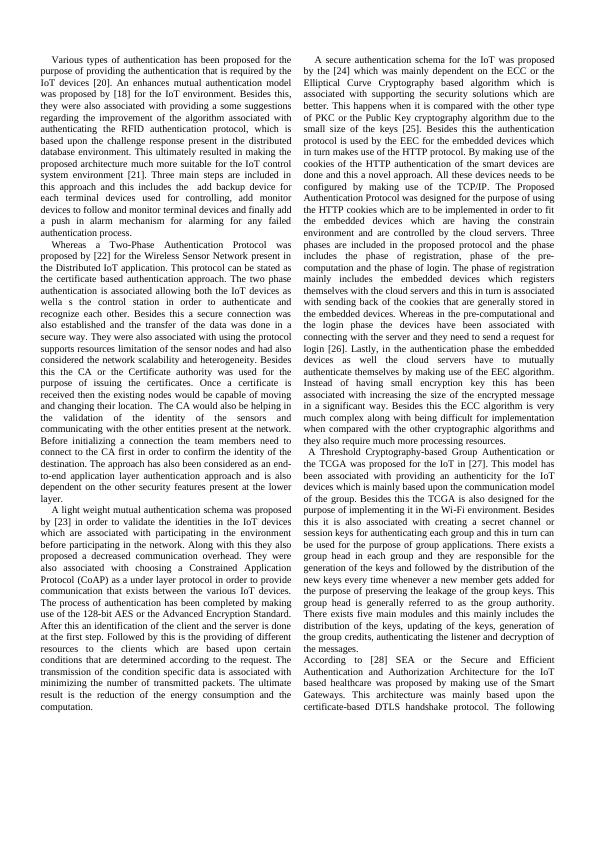IoT in Healthcare Assignment PDF
Added on 2021-05-27
7 Pages7185 Words137 Views
IoT in Healthcare[Name of the author][Designation of the Author][Available at]

ABSTRACT – IoT or the Internet of Things is considered as a powerful rising domain, which is associated with thevarious type of embedded devices or sensors. This sensors or embedded devices have the capability of connectingthemselves and exchange the information over the internet. The use of the IoT devices are increasing day by day and thedata provided by this devices are also critical. For this reason, it is very essential to have certain security constraints,which would be helping in the securing of the data along with special authentication schemes, which are not associatedwith the consumption of the high computing as well as the energy resources. This paper would be mainly discussingabout the IoT healthcare usage. A literature review has been conducted in this report regarding the usage of the IoT inhealthcare besides this the report also discusses about the past and the present works done with the IoT in healthcare.1.INTRODUCTION (15 MARKS)Internet of things or the IoT can be considered as one of themost common research topic. The growt of this technologyhas been greatly favored by the various type of advancementsthat has occurred in the field of electronics, IPv6 and thewireless networks [1]. The use of IoT has greatly increasedand it is being used in various environments, which includesthe homes, healthcare, and many more. Besides this varioustype of approached have been proposed which can be used foreth purpose of controlling the IoT devices. The major concernregarding the use of the IoT includes the various type ofsecurity issues. The security concerns are to be kept in thehighest priority and should be first topic for the research [2].The interest of body wearable is increasing day by daywhich is acting as a powerful tool for different application ofhealthcare and also the different devices. Different IoTdevices are available which are currently being used forvarious purposes which mainly includes the personalhealthcare, awareness regarding various activities and fitness. 2.BACKGROUND/LITERATURE REVIEWVarious researchers have been associated with proposingnew techniques of clinical application of the IoT technology.This technology has greatly helped in remote healthcaremonitoring along with functionalities for long-term recordingof the health statues [3]. It has been seen that most of theremote health care frameworks, which has been proposed,consists of three tiers and this includes the body sensornetwork tier, communication and networking tier and lastlythe processing and the analyzing nodes. The first tier or thebody sensor network tier mainly includes the various wearablesensors, which works like as the unit for data acquisition. Thesecond tier or the communication and the networking and theservices are associated with the collection of the data from thesensors and then forward the data to the next tier [4][5]. Thelast tier, which is associated with the processing and analyzingof the nodes [6][7]. Most of the researchers have been facing a certainchallenges. The main challenges which the researcher arefacing while proposing new authentication mechanism butalso while proposing new authentication mechanism thatwould be responsible for supporting the different kinds of IoTdevices [8]. The authentication standards that the smartphones are having would be applicable for the smart devicesas well. By smart devices, we mainly mean the smart watches,smart thermostat and many more [9].The researchers have been capable of proposing two maindevice identity security solutions, this mainly includes thePhysical protection solution, and the cryptography basedauthentication solution [10]. The main purpose of designingthe physical protection approach is for protecting the devicefrom being damaged or attacked at the level of the physicallayer and this is mainly done application of the variousphysical concepts [11]. Along with this, the cryptographybased authentication approach is mainly designed by makinguse of the IoT Based RFID in the field of security. Besidesthis it also consists of various features and differentalgorithms has been proposed which are based upon the IoTRFID [12].There exists limited number of resources in the IoT devicesand all this are connected to the resources. This ultimatelymakes the devices vulnerable to various kind of risks and thedevices become vulnerable to this attack [13]. In order toguarantee the security and also to identify the identitiesauthentication is needed and this would be helping inpreventing the attackers and other type of malicious attacks[14]. High resources are required for the processing in thetraditional authentication methods. Besides this, the IoT isalso considered as a constraint resource environment, which ishaving a limited number of resources. Along with this, alightweight authentication approach assisted by the robustsecurity features which is generally required for preserving theenergy and to fit the processing capabilities [15][16]. Some of the latest authentication approach have been usedfor the purpose of providing a secure communication. Theapproaches have been associated with the use of the HTTPprotocol in order to authenticate the communication suffer[17]. In addition, this is done from the high overhead, which isresulted from the usage of the HTTP protocol. This HTTPprotocols are not at all optimized for the IoT environment,which are having limited resources. Whereas the otherapproaches are associated with the usage of the AES in orderto encrypt the communication [18]. The AES is associatedwith the usage of the long encryption keys along with thecomplex calculations which are ultimately resulting in thehigh consumption of the power and are also not fitted for therequirements of the IoT energy resources which are restricted[19].2.1Related work

Various types of authentication has been proposed for thepurpose of providing the authentication that is required by theIoT devices [20]. An enhances mutual authentication modelwas proposed by [18] for the IoT environment. Besides this,they were also associated with providing a some suggestionsregarding the improvement of the algorithm associated withauthenticating the RFID authentication protocol, which isbased upon the challenge response present in the distributeddatabase environment. This ultimately resulted in making theproposed architecture much more suitable for the IoT controlsystem environment [21]. Three main steps are included inthis approach and this includes the add backup device foreach terminal devices used for controlling, add monitordevices to follow and monitor terminal devices and finally adda push in alarm mechanism for alarming for any failedauthentication process.Whereas a Two-Phase Authentication Protocol wasproposed by [22] for the Wireless Sensor Network present inthe Distributed IoT application. This protocol can be stated asthe certificate based authentication approach. The two phaseauthentication is associated allowing both the IoT devices aswella s the control station in order to authenticate andrecognize each other. Besides this a secure connection wasalso established and the transfer of the data was done in asecure way. They were also associated with using the protocolsupports resources limitation of the sensor nodes and had alsoconsidered the network scalability and heterogeneity. Besidesthis the CA or the Certificate authority was used for thepurpose of issuing the certificates. Once a certificate isreceived then the existing nodes would be capable of movingand changing their location. The CA would also be helping inthe validation of the identity of the sensors andcommunicating with the other entities present at the network.Before initializing a connection the team members need toconnect to the CA first in order to confirm the identity of thedestination. The approach has also been considered as an end-to-end application layer authentication approach and is alsodependent on the other security features present at the lowerlayer. A light weight mutual authentication schema was proposedby [23] in order to validate the identities in the IoT deviceswhich are associated with participating in the environmentbefore participating in the network. Along with this they alsoproposed a decreased communication overhead. They werealso associated with choosing a Constrained ApplicationProtocol (CoAP) as a under layer protocol in order to providecommunication that exists between the various IoT devices.The process of authentication has been completed by makinguse of the 128-bit AES or the Advanced Encryption Standard.After this an identification of the client and the server is doneat the first step. Followed by this is the providing of differentresources to the clients which are based upon certainconditions that are determined according to the request. Thetransmission of the condition specific data is associated withminimizing the number of transmitted packets. The ultimateresult is the reduction of the energy consumption and thecomputation.A secure authentication schema for the IoT was proposedby the [24] which was mainly dependent on the ECC or theElliptical Curve Cryptography based algorithm which isassociated with supporting the security solutions which arebetter. This happens when it is compared with the other typeof PKC or the Public Key cryptography algorithm due to thesmall size of the keys [25]. Besides this the authenticationprotocol is used by the EEC for the embedded devices whichin turn makes use of the HTTP protocol. By making use of thecookies of the HTTP authentication of the smart devices aredone and this a novel approach. All these devices needs to beconfigured by making use of the TCP/IP. The ProposedAuthentication Protocol was designed for the purpose of usingthe HTTP cookies which are to be implemented in order to fitthe embedded devices which are having the constrainenvironment and are controlled by the cloud servers. Threephases are included in the proposed protocol and the phaseincludes the phase of registration, phase of the pre-computation and the phase of login. The phase of registrationmainly includes the embedded devices which registersthemselves with the cloud servers and this in turn is associatedwith sending back of the cookies that are generally stored inthe embedded devices. Whereas in the pre-computational andthe login phase the devices have been associated withconnecting with the server and they need to send a request forlogin [26]. Lastly, in the authentication phase the embeddeddevices as well the cloud servers have to mutuallyauthenticate themselves by making use of the EEC algorithm.Instead of having small encryption key this has beenassociated with increasing the size of the encrypted messagein a significant way. Besides this the ECC algorithm is verymuch complex along with being difficult for implementationwhen compared with the other cryptographic algorithms andthey also require much more processing resources. A Threshold Cryptography-based Group Authentication orthe TCGA was proposed for the IoT in [27]. This model hasbeen associated with providing an authenticity for the IoTdevices which is mainly based upon the communication modelof the group. Besides this the TCGA is also designed for thepurpose of implementing it in the Wi-Fi environment. Besidesthis it is also associated with creating a secret channel orsession keys for authenticating each group and this in turn canbe used for the purpose of group applications. There exists agroup head in each group and they are responsible for thegeneration of the keys and followed by the distribution of thenew keys every time whenever a new member gets added forthe purpose of preserving the leakage of the group keys. Thisgroup head is generally referred to as the group authority.There exists five main modules and this mainly includes thedistribution of the keys, updating of the keys, generation ofthe group credits, authenticating the listener and decryption ofthe messages. According to [28] SEA or the Secure and EfficientAuthentication and Authorization Architecture for the IoTbased healthcare was proposed by making use of the SmartGateways. This architecture was mainly based upon thecertificate-based DTLS handshake protocol. The following

End of preview
Want to access all the pages? Upload your documents or become a member.
Related Documents
The internet of things in healthcare: An overviewlg...
|5
|4243
|31
Technological innovation | Conceptslg...
|13
|3100
|44
IoT in Healthcare: Advantages, Challenges, and Current Methodologieslg...
|9
|7876
|124
IoT in Healthcare: Securing Data and Enhancing Authentication for Wearable Deviceslg...
|29
|9374
|104
IoT in Healthcare Industry - Literature Review and Annotated Bibliographylg...
|7
|1755
|212
Information Security Assignment : iot security research paperslg...
|11
|2361
|349
